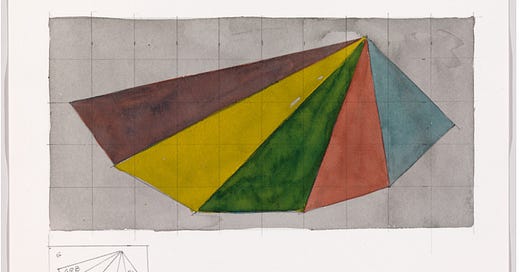You haven’t yet met my peg people, who are new on the scene this summer, three utterly simple little wooden forms who teach me so much. In the mornings, I slide them across my desk into the just right shape by feel—isosceles, scales, equilateral, acute, obtuse. Their taut triangles pull them from sleep. They form alliances, one by the windowsill, two conspiring at the base of the lamp. Or all three emerge equally confident, maintaining form, speaking from difference. Any which way, once configured, they come to life—seemingly spontaneously—sometimes in fresh incarnations, sometimes in old ones, but always with a story to tell. The tension sparks—and they speak!
I remember finding something sad in the stripped bare playthings of the Waldorf kindergarten when I used to drop off my kids, but I see now that the trait of omni-identity is so valuable. While an amulet or a talisman holds an anchor point, tethering a specific current in material form, these faceless, shapeshifting wooden guys are the opposite—and it’s intoxicating. They are everyone and everything—mermaids, deities, despicable schemers, 18th century royalty or Dust Bowl dreamers, and they always jump right to the flashpoint, the drama between them. They’re a fascinating antennae for a whole world of possibilities that occur when interior and exterior meet. And it’s good to know that childhood’s imaginative potential—it’s still there, apparently, just waiting for a match like a pile of tinder.
I decided to populate my desk this way when three ideas colluded in a triangle of their own: First, I thought of a friend who facilitates Family Constellation work, who told me she streamlines the process by using objects as stand-ins for relatives—even stuff that’s sitting around the kitchen—rather than humans, as the practice is most often taught. Humans cause cross-currents with their own energies, and it’s cleaner, she says, allowing quicker access to the relational dynamics between a set of avatars that you can arrange on a table. Second, I remembered a client who, in part, unlocked a bout of writer’s block by buying herself some dolls. She had stopped playing with dolls abruptly in middle school, she realized, and, though she is a brilliant fiction writer of much renown, some of her creativity had gone with them, packed away in the attic. The third idea came when working through the classic coaching framework of the Drama Triangle*. I hadn’t offered this to clients in a long time because there was always something forced about it, useful as it can be. But I revamped the format with peg people and doors swung wide. (Note: Description of Drama Triangle below, for those not familiar.)
Some part of this pegs practice is about spending more time musing in the material plane, this summer. The noisy upheaval of the last year has brought new preciousness to these days, every berry, every strange bloom, each warm summer breeze and every moment of live communion. I’m writing this to you by hand. I’ll open a computer to type it later—or tomorrow. I met a woman recently, probably 65 or 70, who has no cell phone and no internet service. Seems plausible. But the impact of her quiet solidity only hit me days later. What would that be like? We all want to know. I remember the old days with the thirst of someone fearful of forgetting the taste of water. More than limiting my screen time because it’s so detrimental, blah blah, it’s this kind of beauty, the summertime in-the-moment kind, that compels me—the milky light of this July morning. And prioritizing the material world.
Okay, so practically speaking, the pegs are useful to me in several other ways…. They’re invaluable when I’m doing my own Drama Triangle work, by assigning them to roles—villain, victim and hero—just to see what they/different parts of me have to share (cheeky!) In the same way, maneuvering strategic ideas around, like chess pieces, gives me a felt-sense for information I couldn’t access otherwise—it’s a window into how ideas relate. Pegs also let *something else* come through when I’m pondering a piece of writing, or a conceptual question. They fuel imagination at the inception point—generating potential fictional scenes instantly and by the dozens. You learn all you need to know about a character through revelations stirred in the dance of proximity. And most potently, it seems, in threes….Who would Romeo and Juliet be without Mercutio? Or Friar Laurence?
So, stones carry too much energy and deep-time history of their own to be perfectly reflective in this type of exercise (too resonant, like humans). I can see using spoons or some other simple manmade object. But truly, if you are at all interested, I would send out for pegs. I sewed a little felt pouch for a trio last week and gave them to an old friend as a birthday gift. Buy extras to give away.
As ever, happy to write to you about all of this. Reach out if you want to say hello—or hit like and share if you find this intriguing. Doing it all as an experiment and we shall see what comes…XJessica
*Drama Triangle: AI can give you a good overview of this psychological tool, a practice of letting an inner Victim, Villain and Rescuer/Hero speak. At its simplest, you allow the more opinionated and volatile parts inside you to have their say for 2 minutes, moving from base to base on the floor (like three baseball bases) as they do. Victim feels helpless and oppressed. Villain blames everyone else. Hero always wants to help, but by ‘protecting others’ is often controlling, enabling the cycle. You really let them exaggerate, and they say the most outrageously illuminating things. This is a very basic description—I offer a much more nuanced version in my sessions. But alas another time.









All the really good sentences :)